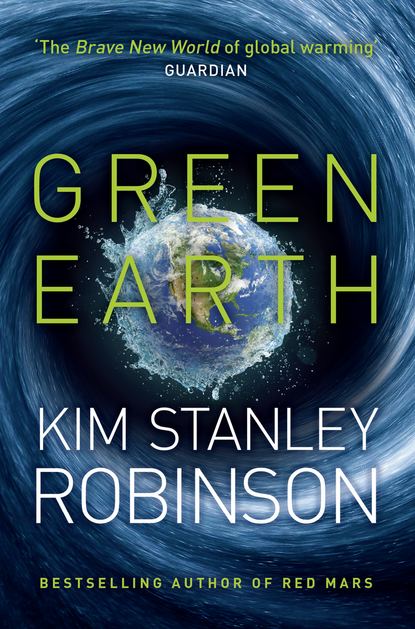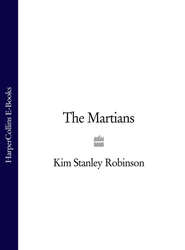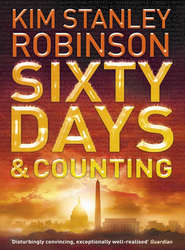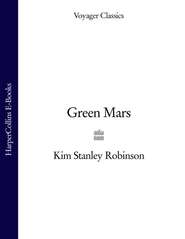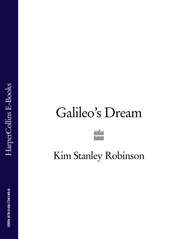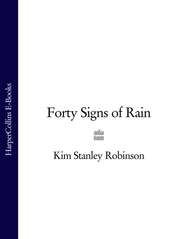По всем вопросам обращайтесь на: info@litportal.ru
(©) 2003-2024.
✖
Green Earth
Автор
Год написания книги
2018
Настройки чтения
Размер шрифта
Высота строк
Поля
“Not up to me, you know that. We’ll see what the panel says. But meanwhile, maybe you should check it out.”
“Oh you like it then.”
“I think it may be interesting, it’s hard to tell. Just don’t drop him.”
“Well, our records show him as already gone back to Pasadena. Like you said, his gig here was temporary.”
“Aha. Man, your research groups have been gutted.”
“Not gutted, Frank, though we’re down to the bare bones in some areas. That’s one of the reasons I’ll be happy when you’re back out here.”
“I don’t work for Torrey Pines anymore.”
“No, but maybe you could rejoin us when you move back.”
“Maybe. If you get new financing.”
“I’m trying, believe me. That’s why I’d like to have you back on board.”
“We’ll see. I’ll be out looking for a place to live in a couple of weeks, I’ll come see you then.”
“Good, make an appointment with Susan.”
Frank clicked off his phone, sat back in his chair thinking it over. Derek was like a lot of first-generation CEOs of biotech start-ups. He had come out of the biology department at UCSD, and his business acumen had been gained on the job. Some people managed to do this successfully, others didn’t, but all tended to fall behind on the science, and had to take on faith what was really possible in the labs. Certainly Derek could use some help in guiding policy.
Frank went back to studying the grant proposal. There were elements of the algorithm missing, as was typical, but he could see the potential for a very powerful method there. Earlier in the day he had thought he saw a way to plug one of the gaps that Pierzinski had left …
“Hmmmm,” he said to the empty room.
On his return to San Diego, he could perhaps set things up quite nicely. There were some potential problems, of course. NSF’s guidelines stated that NSF always kept a public right use for all grant-subsidized work. That would keep any big gains from going to any individual or company, if it was awarded a grant. Private control could only be kept if no public money had been granted.
Also, the P.I. on the proposal was Pierzinski’s advisor at Caltech, battening off the work of his students in the usual way. Caltech and the P.I. would hold the rights to anything the project made, along with NSF, even if Pierzinski later moved. So, assuming Pierzinski moved back to Torrey Pines Generique soon, it would be best if this particular proposal of his failed. Then if the algorithm worked and became patentable, Torrey Pines would keep all the profit from whatever it made. A big patent was often worth billions.
This line of thought made Frank feel jumpy. In fact he was on his feet, pacing out to the mini-balcony and back in. Then he remembered he had been planning to go to Great Falls anyway. He pulled his climbing kit out of the closet, changed clothes, and went back down to his car.
The Great Falls of the Potomac was a complicated thing, a long tumble of whitewater falling down past a few islands. The spray it threw up seemed to consolidate and knock down the humidity, so that paradoxically it was less humid here than elsewhere, although wet and mossy underfoot.
Frank walked downstream along the edge of the gorge. Below the falls the river recollected itself and ran through a defile called Mather Gorge, a ravine with a south wall so steep that climbers were drawn to it. One started at the top, rappelled down to the river, and climbed back up with a top belay. Carter Rock was Frank’s favorite.
There were about as many single climbers like Frank here as there were duets. Some even free-soloed the wall, dispensing with all protection. Frank liked to play it just a little safer than that.
The few routes available were all chalked from repeated use. The river and its gorge created a band of open sky that was unusual for D.C. This as much as anything gave Frank the feeling that he was in a good place: on a wall route, near water, open to the sky. Out of the claustrophobia of the great hardwood forest, one of the things about the East Coast Frank hated most. There were times he would have given a finger for the sight of open land.
Now, as he rappelled down to the small tumble of big boulders at the foot of the cliff, chalked his hands, and began to climb the fine-grained old schist of the route, he cheered up. He focused on his immediate surroundings to a degree unimaginable when he was not climbing. It was like his math work, only then he wasn’t anywhere at all. Here, he was right on these very rocks.
This route was about a 5.8 or 5.9 at its crux, much easier elsewhere. It was hard to find really difficult pitches here, but that didn’t matter. The constant roar and spray didn’t matter. Only the climbing mattered.
His legs did most of the work. Find the footholds, fit his rock-climbing shoes into cracks or onto knobs, then look for handholds. Climbing was the bliss of perfect attention, a kind of devotion or prayer. Or simply a retreat into the supreme competencies of the primate cerebellum. A lot was conserved there.
By now it was evening, a sultry summer evening, sunset near, the air going yellow. He topped out and sat on the rim, feeling the sweat on his face fail to evaporate.
There was a kayaker, below in the river. A woman, he thought, though she wore a helmet and was broad-shouldered and flat-chested. Paddling smoothly upstream, into the hissing water still recollecting itself as a liquid. Upstream from her began a steep rapids.
The kayaker pushed up into this wilder section, paddling hard upstream, then holding her position against the flow while she studied the falls ahead. Then she took off hard again, attacking a smooth flow, a kind of ramp through the smash, up to a terrace in the whitewater. When she reached the little flat she rested again, in another maintenance paddle, gathering her strength for the next salmonlike climb.
Abruptly leaving the refuge of the flat spot, she attacked another ramp that led up to a bigger plateau of flat black water. There she appeared to be stuck, but all of a sudden she attacked the water with a fierce flurry of paddle strokes, and seemingly willed her craft up the next pouring ramp. Five or seven desperate seconds later she leveled out again, on a tiny little bench of a refuge. After only a few seconds she took off and fought upstream, fists moving fast as a boxer’s, the kayak at an impossible angle, looking like a miracle—until all of sudden it was swept back down, and she had to make a quick turn and then take a wild ride, bouncing down the falls by a different and steeper route than the one she had ascended, losing in a few seconds the height that she had worked a minute or two to gain.
“Wow,” Frank said, smitten.
She was already almost down to the hissing tapestry of flat river right below him, and he felt an urge to wave to her, or stand and applaud. He restrained himself, not wanting to impose upon another athlete deep in her own space. It was sunset now, and the smooth stretches of the river had turned a pale orange. Time to go home and try to fall asleep.
“ISO kayaker gal, seen going upstream at Great Falls. Great ride, I love you, please respond.”
He would not send that in to the free papers, but only spoke it as a kind of prayer to the sunset. Down below the kayaker was headed upstream again.
It could be said that science is boring, or even that science wants to be boring, in that it wants to be beyond all dispute. It wants to understand the phenomena of the world in ways that everyone can agree on; it wants to make assertions that if tested by any sentient being would cause that being to agree with the assertion. Complete agreement; the world put under a description; stated that way, it begins to sound interesting.
As indeed it is. Nevertheless, the details of the everyday grind of scientific practice can be tedious, even to the practitioners. A lot of it, as with most work in this world, involves wasted time, false leads, dead ends, faulty equipment, dubious techniques, bad data, and a huge amount of detail work. Only when it is written up in a paper does it tell a tale of things going right, in meticulous replicable detail, like a proof in Euclid. That stage is a highly artificial result of a long process of grinding.
In the case of Leo and his lab, and the matter of the new targeted nonviral delivery system from Maryland, several hundred hours of human labor and many more of computer time had been devoted to an attempted repetition of an experiment described in the crucial paper, “In Vivo Insertion of cDNA 1568rr Into CBA/H, BALB/c, and C57BL/6 Mice.”
In the end, Leo had confirmed the hypothesis he had formulated the very moment he had first read the paper: “It’s a goddamned artifact.”
Marta and Brian sat there staring at the printouts. Marta had killed a couple hundred of the Jackson Lab’s finest mice to confirm this theory of Leo’s, and now she was looking more murderous than ever. You didn’t want to mess with Marta on the days when she had to sacrifice some mice, nor even talk to her.
Brian sighed.
Leo said, “It only works if you pump the mice so full of the stuff they just about explode. I mean look at them, they look like guinea pigs. Their little eyes are about to pop out of their heads.”
“It’s no wonder,” Brian said. “There’s only two milliliters of blood in a mouse, and we’re injecting them with one.”
Leo shook his head. “How the hell did they get away with that?”
“The CBAs are kind of round and furry from the get-go.”
“What are you saying, they’re bred to hide artifacts?”
“No.”
“It’s an artifact!”
“Well, it’s useless, anyway.”
An artifact was an experimental result specific to the methodology of the experiment, but not illustrating anything beyond that. A kind of accident, and in a few celebrated cases, part of a deliberate hoax.
So Brian was trying to be careful about using the word. It was possible that it was no worse than a real result that happened to be useless for their purposes. Trying to turn things people have learned about biology into medicines led to that; it happened all the time, and all those findings were not necessarily artifacts. They just weren’t useful facts.
Getting a useful medicinal fact was usually a matter of two to ten years of work, costing anywhere up to $500 million. In this case, however, Leo was dealing with a method Derek Gaspar had bought for $51 million on spec, a method for which there could be no stage-one human trials: “No one’s gonna let themselves be blown up like a balloon! Your kidneys would get swamped, or some kind of edema would kill you.”





